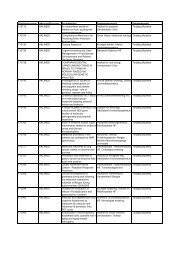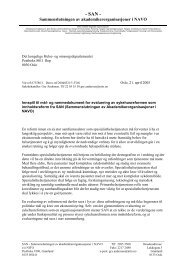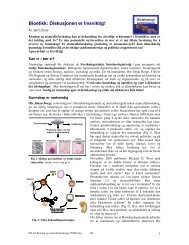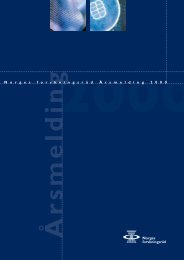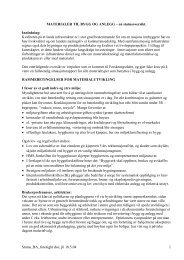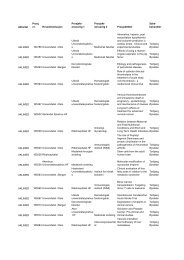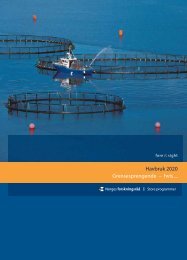A Revolution in R&D
A Revolution in R&D
A Revolution in R&D
You also want an ePaper? Increase the reach of your titles
YUMPU automatically turns print PDFs into web optimized ePapers that Google loves.
mational quality to the level of a known target’s<br />
would be more than recouped <strong>in</strong> due course.<br />
The overall cost of these novel targets—rais<strong>in</strong>g<br />
their <strong>in</strong>formational quality and then pursu<strong>in</strong>g them<br />
down the value cha<strong>in</strong>—is bound to rise <strong>in</strong>itially.<br />
However, with<strong>in</strong> three to five years from the <strong>in</strong>itial<br />
discovery of a target <strong>in</strong> a novel class, accord<strong>in</strong>g to<br />
our model, the overall cost <strong>in</strong>crease per novel-class<br />
drug could return to average.<br />
Where do the added costs come from? And what<br />
must happen to offset them?<br />
The Cost of Quality Control<br />
Our model predicts that the typical <strong>in</strong>crease will be<br />
about $200 million and more than one year per<br />
drug (that is, a total cost of $790 million versus<br />
$590 million, and a total time to drug of 13.8 years<br />
versus 12.7 years). The <strong>in</strong>crease is ma<strong>in</strong>ly attributable<br />
to the extra time needed to understand target<br />
function and develop appropriate assays <strong>in</strong> target<br />
validation and screen<strong>in</strong>g; also, to the need to screen<br />
a higher proportion of compounds, s<strong>in</strong>ce an appropriate<br />
subset of a larger library cannot be selected<br />
<strong>in</strong> advance.<br />
Chemical optimization costs would <strong>in</strong>crease only if<br />
the novel target required a novel compound (by no<br />
means a necessary requirement, though certa<strong>in</strong>ly a<br />
possible one occasionally). Our model exam<strong>in</strong>es<br />
this worst-case scenario explicitly. If a novel target<br />
does happen to require a novel compound, or a<br />
compound unfamiliar to the medic<strong>in</strong>al chemists,<br />
the potential efficiency loss causes a further<br />
<strong>in</strong>crease of $290 million and more than two years<br />
per drug (that is, a total cost of about $1.1 billion<br />
versus $590 million, and a total time to drug of 15<br />
years versus 12.7 years). The additional <strong>in</strong>creases<br />
here would be due to the extra time needed now for<br />
medic<strong>in</strong>al chemists to learn how to modify the compound<br />
and atta<strong>in</strong> specific properties through trial<br />
and error. But this worst-case scenario should not<br />
be very common.<br />
Mov<strong>in</strong>g further still down the value cha<strong>in</strong>, to the<br />
precl<strong>in</strong>ical and cl<strong>in</strong>ical phases, costs are not<br />
expected to <strong>in</strong>crease. The downstream success rate<br />
for novel compounds or targets should turn out to<br />
be much the same as that for known compounds or<br />
targets, as long as the same standards are applied.<br />
There should be no significant <strong>in</strong>crease <strong>in</strong> toxicity<br />
or decrease <strong>in</strong> efficacy, other than <strong>in</strong> very unlikely<br />
circumstances—for <strong>in</strong>stance, if exist<strong>in</strong>g animal<br />
models somehow proved less suitable, or if drugs<br />
for novel target classes were to <strong>in</strong>teract with metabolic<br />
pathways <strong>in</strong> utterly unfamiliar ways.<br />
Offsett<strong>in</strong>g the Costs<br />
Rais<strong>in</strong>g the <strong>in</strong>formational quality of novel targets<br />
<strong>in</strong>volves a heavy <strong>in</strong>vestment, but it is a wise <strong>in</strong>vestment.<br />
And a fairly quick one: knowledge about<br />
one novel target quickly elucidates other potential<br />
targets <strong>in</strong> the same class. Thanks to feedback<br />
loops, knowledge <strong>in</strong>creases geometrically. As more<br />
is learned, the level of <strong>in</strong>vestment can tail off<br />
accord<strong>in</strong>gly.<br />
In any case, the alternatives to mak<strong>in</strong>g that early<br />
<strong>in</strong>vestment <strong>in</strong> <strong>in</strong>formational quality are far from<br />
attractive. On the one hand, dropp<strong>in</strong>g the targets<br />
would be terribly short-sighted: companies would<br />
be forgo<strong>in</strong>g the opportunity to discover and exploit<br />
untapped sources of revenue. On the other hand,<br />
push<strong>in</strong>g novel targets onward without adequate<br />
<strong>in</strong>formation on them would almost certa<strong>in</strong>ly result<br />
<strong>in</strong> a higher failure rate downstream, with all the<br />
associated implications for cost. An <strong>in</strong>creased failure<br />
rate of just 10 percent across chemical optimization<br />
and all of development would on average<br />
<strong>in</strong>crease costs by about $200 million per drug.<br />
To sum up, then: costs <strong>in</strong>curred early <strong>in</strong> the value<br />
cha<strong>in</strong> (by <strong>in</strong>formation gather<strong>in</strong>g) look preferable<br />
to those that would otherwise be <strong>in</strong>curred later (as<br />
the result of a higher downstream failure rate). All<br />
the more so, given that the early costs should soon<br />
beg<strong>in</strong> fall<strong>in</strong>g (<strong>in</strong>vestment <strong>in</strong> <strong>in</strong>formation is almost<br />
always associated with an experience curve): as<br />
novel target classes become <strong>in</strong>creas<strong>in</strong>gly familiar, it<br />
will become <strong>in</strong>creas<strong>in</strong>gly efficient and economical<br />
to pursue new targets with<strong>in</strong> those classes. So with<br />
proper handl<strong>in</strong>g, the burden of that early cost<br />
<strong>in</strong>crease is just a short-term one, and the productivity<br />
of genomics-driven R&D should soon return<br />
19



